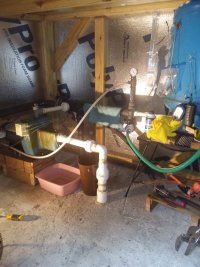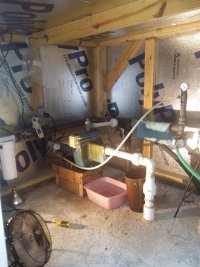Dixon
New Member
My last visit to the forum was about 3 years ago and was about the same well. We fixed it then, hopefully we can solve it now.
To recap:
The residential well is 33 years old, 27' deep, and in the Atlantic Coastal Plain Aquifer (sand/fine gravel). The well has a 2" casing with a 1 1/4" check valve between the casing and the pump. (I removed the drop pipe and plumbed into the well casing 10-15 years ago). The pump is a rebuilt 1hp SNE StaRite jet pump (pump's been in operation @ 3 years). It adequately supplied 6+ gpm for the house & seasonal lawn irrigation. Pressure switch adjusted 30/50, tank cut in 28 psi. The tank test is good.
In 2019 the rebuilt pump ran unloaded at 6.24 amps (discharge valve wide open)
It ran 6.72 amps loaded (valve nearly closed, 50 psi). Pump data plate shows 7.4 max amps (240v)
Three years ago the well's static water level was thirteen feet from the ground's surface. Today the water level is 16 feet down. The water table has dropped three feet. Presumably due to drought? We have recently endured moderate to severe drought after several years of being awash in rainfall following numerous hurricanes and two floods.
I tested my sprinkler system in May this year after it was shut down for the winter. I found out the well system was losing pressure & spitting air after 7-9 minutes of run time.
I indefinitely stopped watering the lawn, adjusted the pressure switch down to 20/40 & the pressure tank cut in to 18 psi. I decided to nurse the system as long as I could and monitor the situation until two weeks ago when it finally failed to build pressure. Naturally it got hot, melted fittings and lost prime. I came home to discover no water and a hot, running pump. I guessed the motor was @ 150° or more. I could place my hand on the motor casing but I wouldn't want to leave it there.
I took the pump apart, resealed it with new parts (impeller/diffuser/seals) and today saw 6.25 amps per leg while filling the pressure tank. The pump continues to erratically build pressure just as it did before the meltdown. The pump may or may not initially build pressure when the switch kicks in. It may just spin and no pressure builds. After a minute or so it may "catch" prime and build to the proper cut off pressure (40 psi). Or it may not. Incidentally, the old impeller and diffuser showed no damage. The pump rebuild really helped nothing.
The problem is frequent and occurs from one cycle to the next. It may run for a minute or more before it picks up the water column and begins pressurizing the system. It may fill to 40 psi and shutoff correctly or it may stall at 36-38 psi instead and run and run with no pressure building to the 40 psi cutoff.
Usually when this happens I can disconnect the pump's power & reconnect power a couple of minutes later and pressure will build to the 40 psi cut off as it should.
No way would the pump be able to reach a 50 or 60 psi cut off as it did three years ago when I had the switch adjusted to 30/50, even 40/60 for awhile.
For days there has been microscopic air bubbles in the water and for several days now a hint of sediment cloudiness could be seen in a glass of water.
Today I opened the well to have a look see and to measure the water table with a plumb bob. I depressurized (emptied) the system of water. I then disconnected the intake pipe/check valve from the pump and the well casing. Air sucked into the pump and air sucked into the well casing meaning the system had been properly sealed. Leaks apparently are not an issue.
One point of interest. The slightly cloudy water I mentioned earlier became significant today after I opened the system up. I would call the change almost sudden. Simply opening up the system caused the cloudiness?
What to do?
I now have 11+ feet of standing water instead of the 14 feet of standing water I used to have. Apparently the 11 feet I now have is not enough.
Is the well recharge too slow due to drought and or sediment building up around the sandpoint? Is the draw down exposing the top of well screen, allowing air in?
Do I install a drop pipe and foot valve at 25' to avoid sucking air from the top of what I am guessing is the 2" casing's sand screen?
Or should I reduce pump size from 1hp to 1/2 hp?
Or do both, add a drop pipe and reduce pump size?
What say you experts?
To recap:
The residential well is 33 years old, 27' deep, and in the Atlantic Coastal Plain Aquifer (sand/fine gravel). The well has a 2" casing with a 1 1/4" check valve between the casing and the pump. (I removed the drop pipe and plumbed into the well casing 10-15 years ago). The pump is a rebuilt 1hp SNE StaRite jet pump (pump's been in operation @ 3 years). It adequately supplied 6+ gpm for the house & seasonal lawn irrigation. Pressure switch adjusted 30/50, tank cut in 28 psi. The tank test is good.
In 2019 the rebuilt pump ran unloaded at 6.24 amps (discharge valve wide open)
It ran 6.72 amps loaded (valve nearly closed, 50 psi). Pump data plate shows 7.4 max amps (240v)
Three years ago the well's static water level was thirteen feet from the ground's surface. Today the water level is 16 feet down. The water table has dropped three feet. Presumably due to drought? We have recently endured moderate to severe drought after several years of being awash in rainfall following numerous hurricanes and two floods.
I tested my sprinkler system in May this year after it was shut down for the winter. I found out the well system was losing pressure & spitting air after 7-9 minutes of run time.
I indefinitely stopped watering the lawn, adjusted the pressure switch down to 20/40 & the pressure tank cut in to 18 psi. I decided to nurse the system as long as I could and monitor the situation until two weeks ago when it finally failed to build pressure. Naturally it got hot, melted fittings and lost prime. I came home to discover no water and a hot, running pump. I guessed the motor was @ 150° or more. I could place my hand on the motor casing but I wouldn't want to leave it there.
I took the pump apart, resealed it with new parts (impeller/diffuser/seals) and today saw 6.25 amps per leg while filling the pressure tank. The pump continues to erratically build pressure just as it did before the meltdown. The pump may or may not initially build pressure when the switch kicks in. It may just spin and no pressure builds. After a minute or so it may "catch" prime and build to the proper cut off pressure (40 psi). Or it may not. Incidentally, the old impeller and diffuser showed no damage. The pump rebuild really helped nothing.
The problem is frequent and occurs from one cycle to the next. It may run for a minute or more before it picks up the water column and begins pressurizing the system. It may fill to 40 psi and shutoff correctly or it may stall at 36-38 psi instead and run and run with no pressure building to the 40 psi cutoff.
Usually when this happens I can disconnect the pump's power & reconnect power a couple of minutes later and pressure will build to the 40 psi cut off as it should.
No way would the pump be able to reach a 50 or 60 psi cut off as it did three years ago when I had the switch adjusted to 30/50, even 40/60 for awhile.
For days there has been microscopic air bubbles in the water and for several days now a hint of sediment cloudiness could be seen in a glass of water.
Today I opened the well to have a look see and to measure the water table with a plumb bob. I depressurized (emptied) the system of water. I then disconnected the intake pipe/check valve from the pump and the well casing. Air sucked into the pump and air sucked into the well casing meaning the system had been properly sealed. Leaks apparently are not an issue.
One point of interest. The slightly cloudy water I mentioned earlier became significant today after I opened the system up. I would call the change almost sudden. Simply opening up the system caused the cloudiness?
What to do?
I now have 11+ feet of standing water instead of the 14 feet of standing water I used to have. Apparently the 11 feet I now have is not enough.
Is the well recharge too slow due to drought and or sediment building up around the sandpoint? Is the draw down exposing the top of well screen, allowing air in?
Do I install a drop pipe and foot valve at 25' to avoid sucking air from the top of what I am guessing is the 2" casing's sand screen?
Or should I reduce pump size from 1hp to 1/2 hp?
Or do both, add a drop pipe and reduce pump size?
What say you experts?
Attachments
Last edited:


